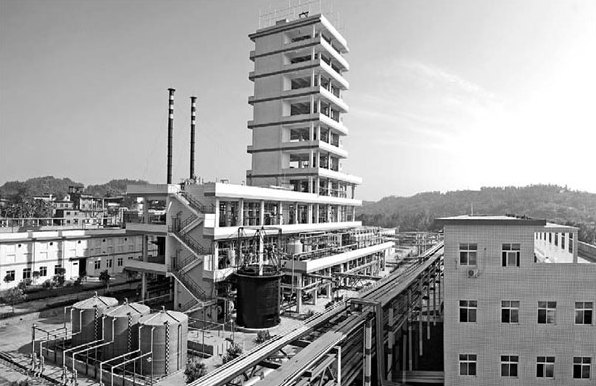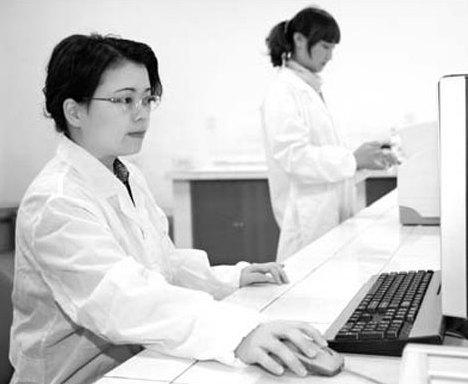Company Special: ChemChina companies give boost to lunar mission
Updated: 2014-01-14 07:15
By Li Fusheng (China Daily USA)
|
||||||||
Most Chinese people grow up listening to stories about the beautiful goddess Chang'e who lives with her pet rabbit in a stately palace on the moon.
That childhood affinity for the moon is probably one of the reasons China's lunar mission in early December ignited almost unrivalled public enthusiasm.
On Dec 14, Chang'e-3 set down on the moon, making China the third country in the world to complete a soft landing with a lunar probe.
|
Founded in the 1960s, the Zhonghao Chenguang Research Institute has developed hundreds of silicone products for space projects. Photos Provided to China Daily |
Hours after landing, the probe lowered its ramp and the Jade Rabbit rover came out for a three-month mission of exploration.
As it trundled toward the Bay of Rainbows bearing a vivid five-star red flag, people watching the live broadcast burst into waves of applause and cheers.
Among the celebrants was Wang Bo, general manger of the North Paint & Coatings Industry Research and Design Institute.
A subsidiary of China National Chemical Corp - widely known as ChemChina - the institute provided the flags on the rover and the probe.
"Despite repeated experiments, we were anxious until the pictures showed our flags withstood the terrible conditions on the moon," Wang said with a relieved smile.
In addition to high radiation, the temperature difference between day and night on the moon can be 300 C.
The conditions and the vacuum of space make it impossible to use the same flags as on Earth.
Under such circumstances, Wang's institute, the first of its kind dedicated to developing coatings, paints and additives, was tasked with making flags of resin.
The first problem researchers encountered was that basic resin cracks at high temperatures.
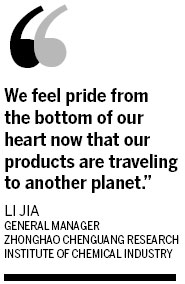
Without any examples, they had to grope after the solution by trial and error. Retired engineers volunteered to join the team and help find the answer.
They finally came up with a synthetic resin that can endure the temperatures on the moon and withstand the radiation.
To ensure the color will not change as the flags are exposed to the lunar environment, researchers also came up with special coatings and techniques through numerous experiments.
"It was really tough," said Tan Zhen, a 25-year old researcher, "Sometimes we worked until 2 am but we felt reinvigorated as soon as we came back in the morning to start experiments again."
Yue Chengjun, general manager of Chemical Industry Corp's Zhonghao Guangming R&D Institute - also a ChemChina operation - gave a sigh of relief. He was soon overwhelmed with pride and excitement as the probe made its soft landing on the moon.
"All our colleagues were somewhat anxious before the Chang'e-3 landed," said Yue.
The institute provided 1.5 tons of oxidant for the probe to travel most of the 380,000 km to the moon after it separated from the carrier rocket.
Yue said the oxidant reacted with other propellant to power more than a dozen engines on the Chang'e-3 to ensure its flight, orbital maneuvers and accurate positioning as it was about to land.
As independent development is stressed in China's space program, Yue said his institute has been working on liquid propellant since the 1990s.
"After years of development, now our products can fully meet the demands of the engines with quality and preparation techniques that reach the world advanced level."
In addition, the institute provided three highly pure gases for the heat-control system in the probe and the rover so that they can work in the harsh conditions.
The Liming Research Institute of Chemical Industry, also a ChemChina subsidiary, played an important role in propelling Chang'e-3's flight.
It provided anhydrous hydrazine, the same fuel used in China's Shenzhou spacecraft, Chang'e satellites and other space missions, said a spokesman at the company.
Another contributor to the lunar mission was the Zhonghao Chenguang Research Institute of Chemical Industry.
Dedicated to developing new chemical materials, the institute provided specially prepared silicone rubber and silicone grease as the cover on the engines on the carrier rocket and the Chang'e-3 satellite.
"We feel pride from the bottom of our heart now that our products are traveling to another planet and we rejoice at China's rapid progress in space technology," said Li Jia, general manager of the institute under ChemChina.
Since its founding in the 1960s, the institute has developed hundreds of silicone products, many of them applied in space-related missions.
A long-term provider to China's Shenzhou program, the institute won accolades as an "excellent supplier" for the country's first manned space docking in 2012.
While admitting that some of the products are not yet at the globally advanced level, Li said she and her colleagues will continue their efforts to push back the frontiers of the field in China and beyond.
In addition to serving the nation's demands, it is working to develop products for civilian use, said Li.
In response to pollution problems in China, the institute came up with a fluororesin product in 2012 that can be used at power plants, waste incineration plants and steelworks to reduce air pollutants and toxic gas, said Li.
lifusheng@chinadaily.com.cn
|
Li Jia, general manager of the Zhonghao Chenguang Institute, is also a researcher who believes that R&D drives a company. |
(China Daily USA 01/14/2014 page14)

 Cristiano Ronaldo wins FIFA best player award
Cristiano Ronaldo wins FIFA best player award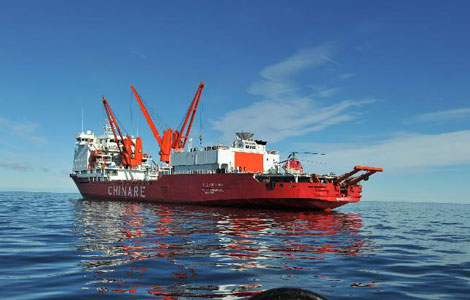
 Xuelong carries on mission after breaking from floes
Xuelong carries on mission after breaking from floes
 Beijing and Sofia vow new initiatives
Beijing and Sofia vow new initiatives
 71st Golden Globe Awards
71st Golden Globe Awards
 Bangkok unrest hurts major projects and tourism industry
Bangkok unrest hurts major projects and tourism industry
 No pant for cold subway ride
No pant for cold subway ride
 Tough army training turns boys into men
Tough army training turns boys into men
 Blaze prompts concern for ancient buildings
Blaze prompts concern for ancient buildings
Most Viewed
Editor's Picks

|
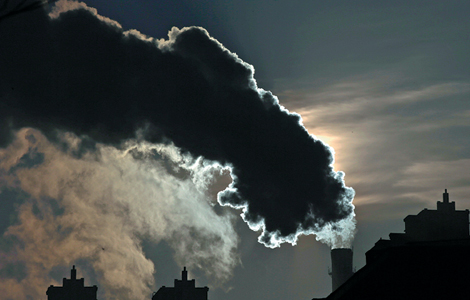
|

|

|

|

|
Today's Top News
Newspapers must change or die
Abe’s brother to explain shrine visit to US
Protests cannot end Thai deadlock: observers
Mercy killing still a hot button issue
China builds army 'with peace in mind'
UN plea made on war victims
Li: China's tech innovation a priority
Less school is better for finding love
US Weekly

|

|
